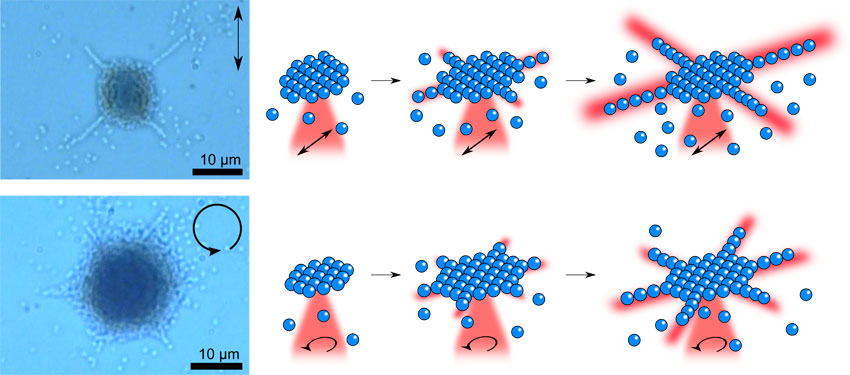Significance Statement
A group of researchers led by Dr. Tetsuhiro Kudo and Professor Hiroshi Masuhara from National Chiao Tung University in Taiwan provided an experimental study that propagation of trapping laser from focal point expands an assembly much larger than the irradiated area with sticking out rows of linearly aligned particles like horns. The work published in Nanoletters, provides new mechanism against previous studies where assemblies were only trapped in the irradiated area by studying the optical trapping of polystyrene particles at glass/solution interface.
The optical trapping system used for this experiment comprises of an inverted microscope and a 1064 nm continuous wave laser as a trapping laser, an objective and collimation lenses, λ/2 or λ/4 wave plate, charge-coupled device camera, and a spectrometer.
Results shown on colloidal assembly formed during optical trapping with the linearly polarized light as time progresses expressed dynamic movement of assembled particles and a random collision with each other. The long and short axes of an ellipse-like assembly were much larger than focal spot (1 μm) at about 14 and 12 μm, respectively. For that of circularly polarized light, a circular-shaped assembly of diameter 20 μm was also seen.
Four horns appeared and became longer, reaching a maximum length of about 10 μm after completion of an elliptical assembly growth which would be challenging in cases of a direct trapping laser. The horns which were tilted at 450 with respect to direction of light polarization maintained an X-like shape despite their random swings. Their interparticle distance was about 1.2 μm, twice the size of effective wavelength which serves as one of the features of an optical binding.
Interestingly, six short horn branches with an angle of 600 to each other were found on the assembly when observing images of circularly polarized light. Optical trapping experiment with circularly polarized light of laser power of 1.8 W ten times showed the probability of observing six horns in 9 min irradiation at 50 %. The six horns shown when compared to that of 1.4 W laser was longer. The authors however concluded that the four horns found in the linearly polarized light were much longer than those of six horns found in the circularly polarized light.
The light propagation through the horns was directly observed to grow from the focus point to the outside area when assemblies were monitored by 1064 nm backscattering imaging. A multiple scattering in the assembly was also observed with assembly structures of four horns and six horns proposed to be tetragonal and closely-packed respectively.
The two transmittance of linearly and circularly polarized light reduced with a large degree in shorter wavelength region compared with the longer one. However, a lower transmittance was found in assembly with the six horns. Further experiments concluded that both structures of the four horns and six horns assembled with the linearly and circularly polarized light respectively.
The findings and methods of this study are relevant in facilitating design of quantum dots, metal nanoparticles, molecular structures, etc. coupled with their crystal design by use of an optical force through light propagation.

Journal Reference
Tetsuhiro Kudo*, Shun-Fa Wang, Ken-ichi Yuyama, Hiroshi Masuhara*. Optical Trapping-Formed Colloidal Assembly with Horns Extended to the Outside of a Focus through Light Propagation, Nano Letters 16 (2016) 3058-3062.
Department of Applied Chemistry and Institute of Molecular Science, National Chiao Tung University, Hsinchu 30010, Taiwan.
Go To Nano Lett.
 Advances in Engineering Advances in Engineering features breaking research judged by Advances in Engineering advisory team to be of key importance in the Engineering field. Papers are selected from over 10,000 published each week from most peer reviewed journals.
Advances in Engineering Advances in Engineering features breaking research judged by Advances in Engineering advisory team to be of key importance in the Engineering field. Papers are selected from over 10,000 published each week from most peer reviewed journals.





